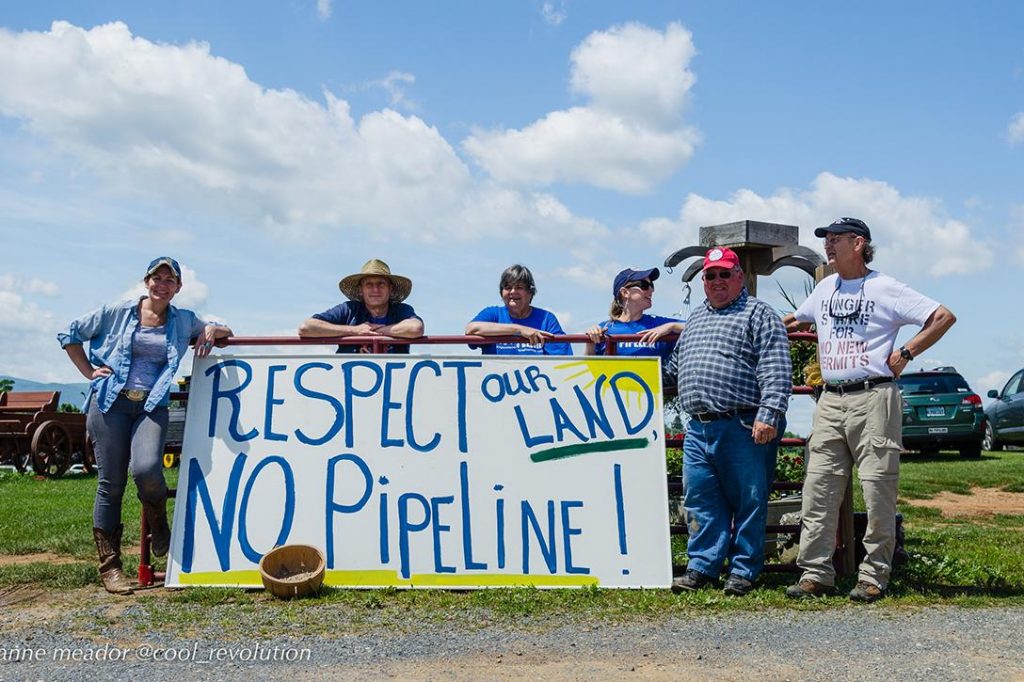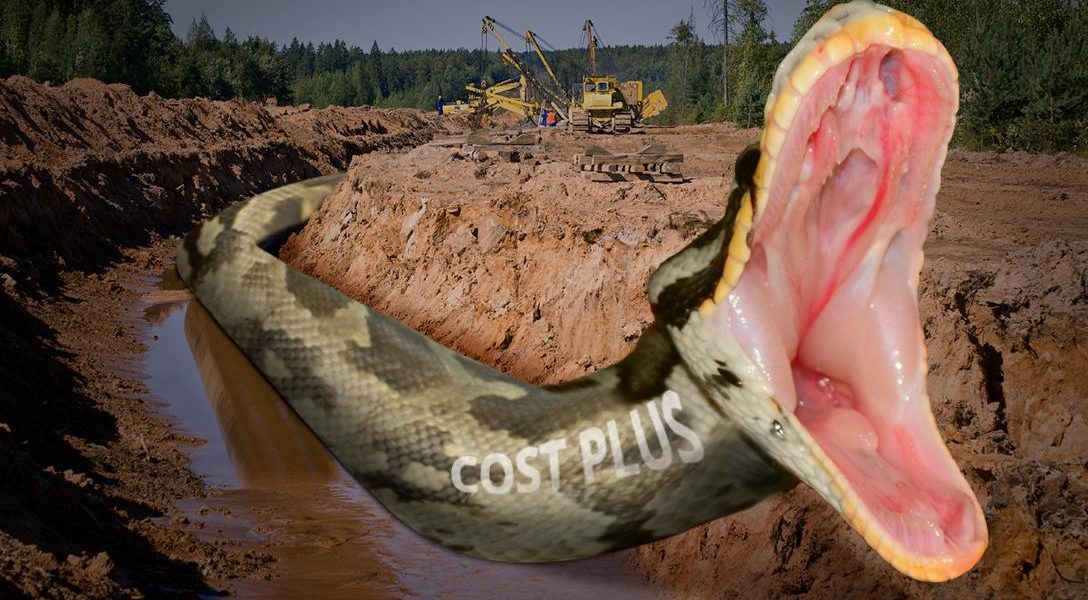Will Activists Be Able to Stop the Atlantic Coast Pipeline?
Big Power Steamrolls The Opposition
The Atlantic Coast Pipeline will enrich investors, but it may permanently scar the Appalachian Trail and jeopardize the health, safety and peace of mind of the region’s most vulnerable residents.
It is the other pipeline. The one hardly anybody is talking about. Not the Dakota Access pipeline, famous for months of resistance by Native American tribes at Standing Rock. Not the Keystone XL Pipeline, rejected by the Obama White House. Both these pipelines, now advanced through executive order by President Donald Trump, continue to generate headlines and controversy.
The Atlantic Coast Pipeline (ACP) seems to be the pipeline that garners the least attention. And yet, to the thousands of people and businesses in its path, it has brought worry and turmoil.
The deadline for public comments on the pipeline is today, April 6. Whether it proceeds will largely depend on the final decision of federal regulators, expected this fall. Construction could begin by the end of the year.
The project, led by Dominion Energy Inc., is a joint venture with three other energy companies — Duke Energy, Piedmont Natural Gas and Southern Company Gas. The $5 billion 550-mile pipeline will bring natural gas — from Ohio, West Virginia and Pennsylvania — to Virginia and North Carolina. To get there, It has to cross through West Virginia, Virginia and North Carolina
While thousands of short-term jobs may be created, critics of the project claim — and Dominion’s own economic analysis confirms — that it would directly support fewer than 300 permanent jobs, including 39 in Virginia and 24 in West Virginia.
Pipeline opponents also question whether the pipeline is needed at all, charging that building the pipeline itself might deliver the profits that energy companies desire — through rate hikes — whether there is consumer demand or not.
That isn’t how the energy companies see things.
According to a Dominion factsheet, the pipeline is necessary “to better serve existing and growing customer demand, improve service reliability, and allow for consumer growth and economic development.”
But the pipeline also will eliminate more than 6,800 acres of forest — an area the size of eight Central Parks. It will dispatch an army of nearly 10,000 construction workers, trucks, and earthmoving equipment into the Appalachian hills and the Blue Ridge Mountains. It will be built near ski and fishing resorts and a large Yoga ashram. The project also will require the construction of three large compressor stations along the route.
There have been scores of protests of the project, both in affected communities, and in Washington, DC. Public meetings and town halls have been packed with residents who charge that the pipeline will disturb environmentally sensitive areas and potentially taint water supplies. Some protesters worry about the impact of a mammoth compressor station in their “backyard.”

Photo credit: Jeremy Buckingham / Flickr (CC BY 2.0)
Chad Oba lives in rural Buckingham County in South Central Virginia. The 70-year-old mental health provider has lived in her historic home with a flourishing garden for 30 years. If the ACP is approved, she’ll be about a mile away from a huge compressor station, which will push up to 1.5 billion cubic feet of natural gas per day through the pipeline.
She expects that for her, a mile away, the sound will be about 50 decibels, or the level of a dishwasher. She wonders what that will be like 24 hours a day, 365 days a year.
“Quiet is very important to me,” she tells WhoWhatWhy. “This is my refuge, my home.” Oba says she and her husband, who is a sculptor, are not wealthy people. “We have one of the three historic homes in this area,” she says. “All we have is here. This is our life investment.”
“There’s a tremendous amount of anxiety,” she says of her and her neighbors. “We don’t know what the future’s going to bring.”
She says that her neighbors in the nearby Union Hill neighborhood will be even more affected by the compressor plant. They value the same things — quiet, a star-studded night sky, fresh air, she says. They will have to deal directly with greater noise and dust, and the light pollution from the operation.
Why would Dominion and other utility companies invest billions of dollars in a pipeline they might not need?
Her neighbors treasure the land’s history, its ties to their ancestors, many of whom are buried on the very plots that she fears will be dug up to build what Oba calls “this mega plant.”
But noise and a marred view are not her only worries. Compressor plants emit toxic chemicals. People living near them have complained of respiratory problems and nosebleeds, she says. (Dominion has promised its compressor stations will be state of the art, and will minimize noise and toxic releases.)
Union Hill has a long history as an African-American enclave. It was home to freed slaves, many of whose descendants still live here. The community is densely populated. The plots of land are small, and many families live near one another. Many of the residents are elderly.
A compressor plant will be built on 68 acres in Union Hill on the site of the Variety Shades plantation. Variety Shades Landowners LLC received $2.5 million from the sale. The amount that Dominion paid is unheard of in this area, Oba says. “That’s $37,000 an acre.” All of the owners are from out of state. It is not known whether they have any family ties to slaveholders.
In contrast, the descendants of slaves, Oba observes, may end up holding properties that will be worth much less than their current value. They won’t receive any compensation. She has termed the plant “another example of environmental racism.”
Oba chairs the Friends of Buckingham, a grassroots group that has publicly engaged on the project, traveling to listening sessions, speaking up before the Buckingham County Board of Supervisors, who voted to approve the construction of the compressor station in an agricultural district, despite the vocal opposition of scores of farmers and landholders. “We haven’t had county support at all,” she says. “They see it as a source of revenue.”
It appears that’s how federal and state officials and regulators also see the project.
Terry McAuliffe, the Democratic governor of Virginia, has strongly endorsed it. “We’re talking jobs, economic development, and it’s good for the environment,” McAuliffe said in 2014.
The Trump administration reportedly has it on a list of its 50 highest priority infrastructure projects with a combined value of more than $137 billion. The list is nearly identical to one submitted by the National Governors Association.
It also has the backing of the building trade unions, which are eager for the up to 10,000 temporary jobs the project will create.
To move forward, the project needs the okay from the Federal Energy Regulatory Commission (FERC). FERC is required by law to evaluate the environmental impacts of the proposal, and to solicit public comment. FERC’s draft review, released last December, was favorable. FERC deemed its environmental impacts “minimal” and able to be “mitigated.” It also stated that “a high level of public participation … helped inform our analysis.”
Workers will dig trenches into steep hillsides. When there’s a heavy rain, he says, the earth that’s been disturbed will slide down the hill and into streams in the valley. Springs that rural residents depend on for their water supply “will be contaminated,” he predicts. The sediment in the water also could kill thousands of fish.
But many protesters don’t feel heard by FERC. The agency, Oba charges, failed to consider “our existence as a viable historic site.”
FERC also has failed to challenge Dominion’s assertion that the pipeline is needed, contends Thomas Hadwin. Hadwin lives in a small town in the rural Shenandoah region of Virginia. But before he moved to Waynesboro, he worked for utility companies in Michigan and New York. He managed the environmental department at New York State Electric and Gas, and so is aware of what utilities must do to get state and federal approval of rate hikes or pipelines.
He got pulled into the ACP controversy when his neighbors, aware of his utility industry background, asked him to look into Dominion’s pipeline proposal. He considers himself “on the side of the utilities,” he says, and he didn’t own any property that would be affected by the project. He attempted to look at the proposals objectively, but what he found, he says, “was a one-sided deal” that benefited only the company. “Dominion flooded everybody with information, but it was incomplete,” Hadwin says. “That bothered me as a utility guy. This isn’t how we behaved.”
Hadwin and other ACP opponents complain that Dominion provides scant evidence that the pipeline is actually needed. FERC is legally required to assess the economic justification for such a project, Hadwin says. But FERC is content if the utility can prove it has “signed contracts” from the companies that will purchase the natural gas.
But here’s the rub: The contracts are mostly between utility holding companies and their subsidiaries. The subsidiaries, Hadwin claims, have to buy the natural gas from their corporate parents, even when they could buy it more cheaply from another supplier.
Why would Dominion and other utility companies invest billions of dollars in a pipeline they might not need?
Hadwin says that utilities know they can recoup their costs, along with a healthy profit, by raising their rates. FERC has agreed to a rate structure that rewards the construction of new natural gas pipelines, he says. Hadwin estimates that the ACP could hike rates in Virginia by more than $200 million.
North Carolina consumers also would be paying more, he says. If Dominion builds a pipeline and also a power plant that is not needed, he says, “the ratepayer is on the hook.” Dominion has 2.6 million customers in both states.
“It’s a windfall for Dominion Resources,” agrees Greg Buppert, senior attorney for the Southern Environmental Law Center (SELC), based in Charlottesville. “They get a 14 to 15% return on their investment.”
Buppert refers to demand projections by PJM Interconnection, a private firm that manages the electric grid. According to PJM, Buppert says, “demand has been static for Virginia and this region for the past decade.” The difference between Dominion’s projections of growing demand and PJM’s are “equivalent to two natural gas-fired power plants.”
SELC also commissioned an economic study of the pipeline from Synapse Energy Economics. That study, Buppert says, estimated that even growing demand can be met by modifications to the existing energy infrastructure without a new pipeline.
The Synapse study also faults Dominion for not factoring in the environmental costs of the project.
Dominion downplays any environmental risks to the project, stating that most of the pipeline will be underground, permitting farming, grazing, and recreational uses once construction is finished. Dominion also contends that Virginia and North Carolina already have more miles of natural gas pipelines now than they do interstate highways. “Pipelines are the safest way to transport energy,” the energy company has stated.
But Dominion has not given FERC and the public enough information about just how it intends to build the pipeline, charges Richard Webb. Webb was a research scientist at the University of Virginia. Now retired, he’s program director for the Dominion Pipeline Monitoring Coalition. The coalition, which includes 15 environmental groups, is part of a larger activist group, 51 organizations strong, the Allegheny-Blue Ridge Alliance.

Photo credit: cool revolution / Flickr (CC BY-NC-ND 2.0)
The public is entitled by law to that type of detail, Webb insists. “We want decisions made according to the rule of law,” he says. “We don’t have that now.”
However, the information that the protesters do have is sufficiently alarming. “It’s hard to imagine” the devastation, Webb says. To lay the underground pipe, construction crews will clear trees and other vegetation in large swaths of the Monongahela National Forest in West Virginia and the George Washington National Forest in Virginia.
The project will create “a long-term scar on the landscape,” Webb says.
About 200 miles of pipeline will be laid in a mountainous region of Virginia and West Virginia, Webb says. Workers will dig trenches into steep hillsides. When there’s a heavy rain, he says, the earth that’s been disturbed will slide down the hill and into streams in the valley. Springs that rural residents depend on for their water supply “will be contaminated,” he predicts. The sediment in the water also could kill thousands of fish.
In some cases, laying underground pipe will actually result in mountaintop removal, says Lewis Freeman, chair and executive director of the Allegheny-Blue Ridge Coalition. In all, he says, “38 miles of ridge tops in Virginia and West Virginia would be leveled.” Hikers on the Appalachian trail and those who drive the Blue Ridge parkway will notice “the visual impairment,” he says.
The pipeline will go through “historic farms” in Bath and Highland counties, Freeman adds. The farms, he says, have been in existence since land was granted to Virginians by King George II. “The properties would be violated,” he asserts.
There are concerns whether drilling a mile underneath a mountain can be done safely, he adds.
Wintergreen is the largest resort that will be affected. Construction near the entrance of the resort will create short-term accessibility problems for visitors, he says. But there is also the concern that should there be a pipeline explosion or fire, there is only one road for emergency responders and to evacuate Wintergreen staff and guests.
A yoga community and retreat center also is unsettled by the ACP. Last year, the ashram formally opposed the project. The Satchidananda Ashram-Yogaville raised serious concerns about Dominion’s plans to build a large compressor station nearby.
The ashram charges that the construction of the pipeline so near the retreat, coupled with air and light pollution from the compressor station a few miles away, would harm the ashram’s economic viability, as well as its spiritual practices. It also worries about potential health risks. Yogaville officials also are concerned about a potential pipeline accident, considering its location is less than a mile from an ashram school and the homes of staff.
Those who oppose the project continue to face daunting odds. If FERC approves the pipeline, Webb and Freeman both say many of the groups opposing the pipeline may go to court to try to block it. But that might not be enough. FERC has a history of permitting construction to go on, even if there’s a lawsuit pending, Webb says.
“That’s a real problem,” SELC’s Buppert says. Delaware Waterkeepers and other environmental groups successfully challenged a pipeline approval by FERC in the federal district appeals court for the District of Columbia, but by the time the court ruled in 2014, pipeline construction was well underway.
Buppert says SELC will be making its case to FERC today, urging the agency to make “an informed decision.”
Webb hopes that Virginia regulators, so far unwilling to buck Dominion, might raise serious concerns about the pipeline’s impact on the region’s water supply. According to the federal Clean Water Act, Webb says, states must certify that a project meets water quality standards. But he concedes that politics might discourage a strong state response, given Dominion’s long history of political donations to Virginia lawmakers.
There might be another wild card. The issue could gain more traction this June, during a highly contested Democratic primary race to succeed McAuliffe. Candidate and former congressman Tom Perriello publicly opposed the pipeline in February, and said he will not take any money from Dominion. His opponent Ralph Northam supports such projects if they pass muster with federal and state regulators. Northam reportedly has received nearly $100,000 in Dominion donations over the course of his political career.
Despite the tough odds, Oba will continue fighting for herself and her Buckingham County neighbors. She has taken comfort in the expression of solidarity from the leaders of the Bold Alliance, one of the drivers of Native American protests against the Dakota Access Pipeline at Standing Rock.
Last summer the Dakota Access protesters visited the Virginia area and planted what Oba calls “sacred corn from the Ponca tribe” along some of the proposed route of the pipeline. Last fall, Bold Alliance president Jane Kleeb and member Wes Mekasi Horinek returned to harvest what they termed “the seeds of resistance.”
“We got to know Mekasi, and we told him our story,” Oba recalls. “We identify with them, and they identify with us.”
This corrected version of the story was posted on April 8, 2017.



